Previewing Maxiotek's MK8115 SSD Controller: Can DRAM-less Drives Make The Cut?
by Billy Tallis on May 9, 2017 8:00 AM ESTMixed Random Read/Write Performance
The mixed random I/O benchmark starts with a pure read test and gradually increases the proportion of writes, finishing with pure writes. The queue depth is 3 for the entire test and each subtest lasts for 3 minutes, for a total test duration of 18 minutes. As with the pure random write test, this test is restricted to a 16GB span of the drive, which is empty save for the 16GB test file.
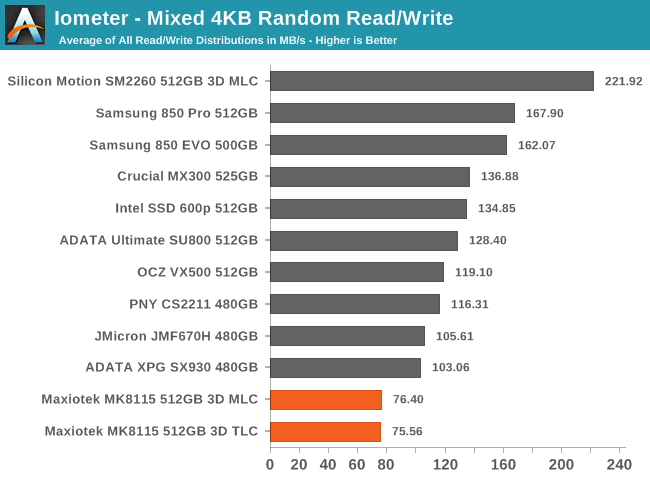
The MK8115 struggled with both random reads and random writes, so it's no surprise to see them turn in the lowest performance scores for the mixed random workload test. The MLC drive is only ahead of the TLC drive by a hair, and the next slowest drive is faster by a third.
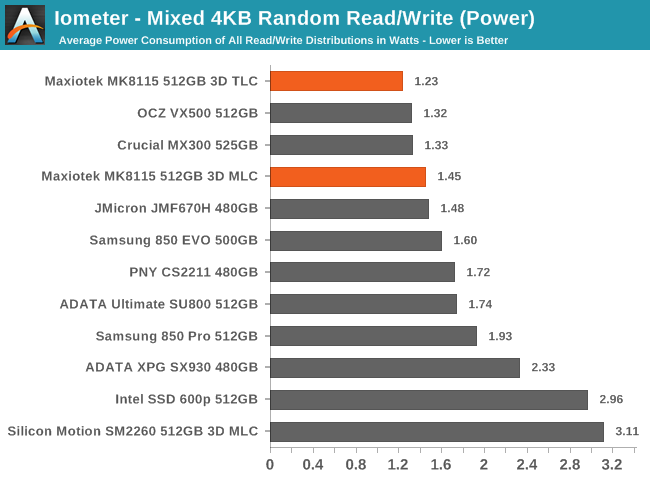
The MK8115 with TLC ends up using less power to deliver almost exactly the same performance, so the TLC drive scores a minor win for efficiency. They're both still beat by a wide range of mainstream SSDs.
 |
|||||||||
Both MK8115 drives show a normal spike in performance at the end of the test when the workload shifts to pure writes. During the rest of the test, performance is mostly constant instead of the more usual pattern of growing steadily with the proportion of writes in the workload. The TLC drive is substantially faster than the MLC drive in the initial all-reads phase of the test, but it is slightly slower through the middle of the test and that gives it the slower overall average.
Mixed Sequential Read/Write Performance
The mixed sequential access test covers the entire span of the drive and uses a queue depth of one. It starts with a pure read test and gradually increases the proportion of writes, finishing with pure writes. Each subtest lasts for 3 minutes, for a total test duration of 18 minutes. The drive is filled before the test starts.
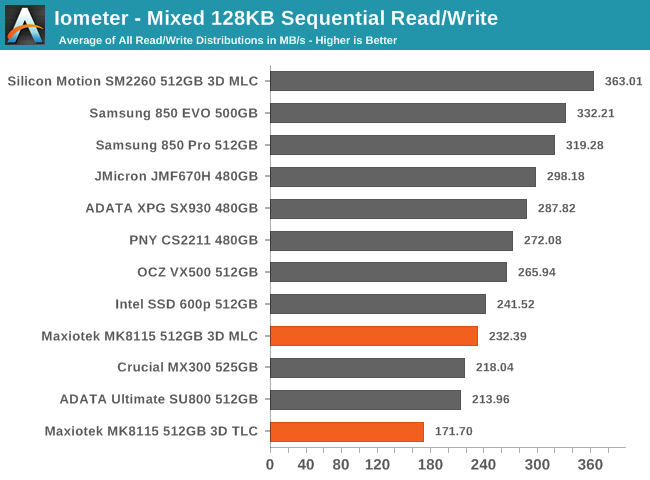
The MK8115 drive with MLC has much higher average performance on the mixed sequential workload test than its TLC counterpart, which is quite clearly the slowest drive. The MLC manages to outperform two TLC drives, but doesn't come close to matching the next slowest MLC drive on this test.
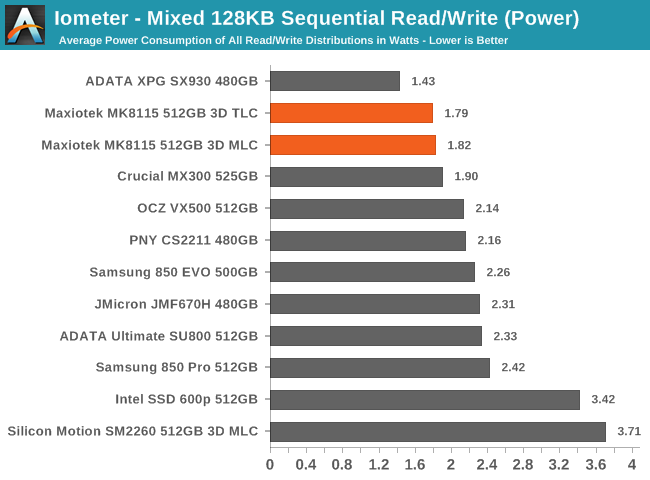
Both MK8115 drives draw about the same amount of power during the mixed sequential workload test. The MLC drive requires slightly more power but is substantially more efficient due to its higher performance, and it actually beats the Crucial MX300 for efficiency here.
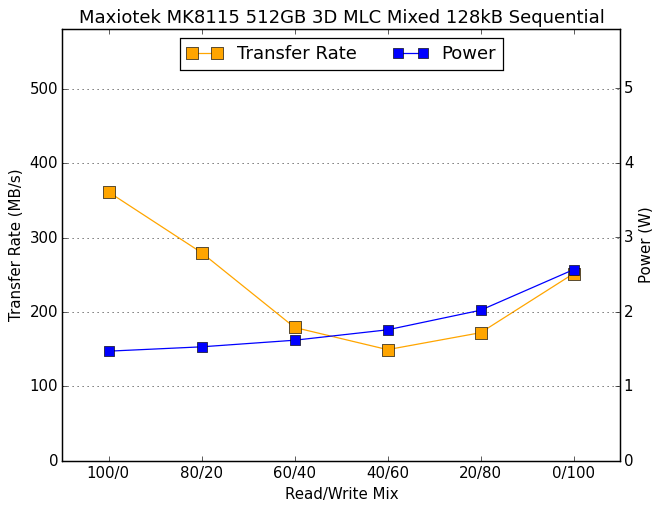 |
|||||||||
The MLC drive's performance curve across the mixed sequential test is the U shape that is normal for mainstream SSDs, though the minimum performance of around 150MB/s is a bit on the low side. The TLC drive by contrast slows down steadily as more writes are added, and doesn't recover any performance near the end of the test.










60 Comments
View All Comments
romrunning - Tuesday, May 9, 2017 - link
Here's an example of performance regression - the Intel 600p versus any other Intel PCIe SSD (like the Intel 750 or P3700). Clear performance drop.Don't confuse it with price differences or target buyer - you only asked for an example of performance regression.
MajGenRelativity - Tuesday, May 9, 2017 - link
The 600p isn't even targeted at the same market segment. That's like saying that every single SSD released since the Intel P4800X is a performance regression because it can't come close to those random IOPS. I'm talking about a performance regression within the same price segment.CheapSushi - Wednesday, May 10, 2017 - link
The Intel 600P is TLC NAND and the Intel 750 is MLC NAND.... maybe you don't know the difference? TLC is inherently slower than MLC; 3 bits per cell vs 2 bits per cell.MajGenRelativity - Thursday, May 11, 2017 - link
A. I know the difference. B. MLC vs TLC isn't even the point. C. My point still stands because the 600p is not targeted at the high end.satai - Tuesday, May 9, 2017 - link
There are some cheap models and there some awesome models (Intel 750 and Intel Enterprise models, Samsung 960s, Optanes...). Pick yourself.MajGenRelativity - Tuesday, May 9, 2017 - link
The Intel Optane enterprise drive certainly is awesome, but I find it's price a bit hard to sell an average consumer on.melgross - Tuesday, May 9, 2017 - link
Well, all new technologies cost the most at first, and much less later. Performance is the opposite. The worst at first, and much better later.Next year, the price of Optane will be half of what it is now, but for a 512GB board, rather than the 375GB board it is now. Still expensive, sure. But you just have to learn to be patient.
WinterCharm - Tuesday, May 9, 2017 - link
On the bright side, Optane should be a lot cheaper to produce in the long run. While it's terrible as an accelerator, it's fantastic as a standalone drive. Prices will come down over time.CheapSushi - Wednesday, May 10, 2017 - link
Is the average consumer one that even reads about these things? The average consumer just goes to Best Buy and a salesman tells them what to get. Anyone who reads AnandTech and/or actually read the reviews about Optane aren't average consumers anyway.MajGenRelativity - Thursday, May 11, 2017 - link
True, but I doubt most of us still have the money for a $1,500 375GB SSD